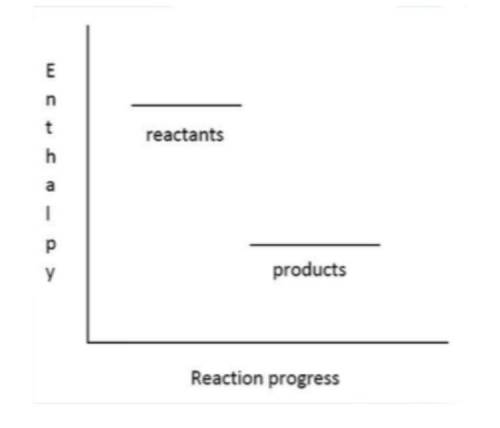
Chemistry, 28.02.2021 17:20 dragador7601
When some solid ammonium nitrate was dissolved in water the temperature decreased from 22 oC to 3 oC. What can be deduced from this observation?
The dissolving is endothermic and ∆H is positive. The dissolving is endothermic and ∆H is negative. The dissolving is exothermic and ∆H is positive. The dissolving is exothermic and ∆H is negative.
Which is a correct statement about an endothermic reaction?
A. The bonds in the reactants are stronger than in the products and ∆H is positive.
B. The bonds in the products are stronger than in the reactants and ∆H is positive.
C. The bonds in the reactants are stronger than in the products and ∆H is negative
D. The bonds in the products are stronger than in the reactants and ∆H is negative.
Which is a correct statement about the following() enthalpy level diagram of a reaction? A. The reaction is exothermic and △H is positive.
E. The reaction is exothermic and △H is negative.
F. The reaction is endothermic and △H is positive.
G. The reaction is endothermic and △H is negative.
Which statements are correct for all exothermic reactions?
I. The products are more stable than the reactants.
II. The bonds in the products are stronger than the bonds in the reactants
III. The enthalpy of the products is less than the enthalpy of the reactants
A. I and II only
B. I and III only
C. II and III only
D. I, II and III


Answers: 2
Another question on Chemistry

Chemistry, 22.06.2019 02:40
Consider the nuclear equation below. 239/94 pu—-> x+ 4/2 he. what is x?
Answers: 2

Chemistry, 22.06.2019 17:30
What will most likely happen in the absence of a cell membrane? a) photosynthesis will not take place. b) the cell will not store food, water, nutrients, and waste. c) energy will not be released during cellular respiration. d) substances will pass in and out of the cell in an uncontrolled manner.
Answers: 1

Chemistry, 22.06.2019 22:00
For a family dinner, jose’s mom baked a loaf of bread. during the meal, his grandmother commented, “this bread is so dense! ” what do you think his grandmother meant by the word dense? you have some ideas regarding density already, but this experiment will enrich your understanding of the relationship between mass, volume and the density of objects. when making measurements in this experiment we will be using si units, the international system of units. the purpose of using si units is to have the ability to communicate and compare data results with other experiments without having to make conversions. measurement symbol si unit length m meter mass kg kilogram volume l liters density kg/l kilograms per liter any calculations that are performed during this experiment will ultimately be reported in scientific notation. recall that scientific notation is extremely important when we have data that is extremely small or large. scientists rely on a standard form of communication to quickly make hypotheses and judgements based on data. what is the density of block a? a0kg/l what is the density of block b? a1kg/l what is the density of block c? a2kg/l what is the density of block d? a3kg/l what is the density of block e? a4kg/l which block is the densest? a5
Answers: 1

Chemistry, 23.06.2019 02:50
For questions 1 and 2, consider the following experimental data.hydrogen emission lines were detected at the following wavelengths (in nm): 121.6102.697.395.093.8question 1use the electromagnetic radiation classifications below and figure 1-1 in the introductory information for this lab (in the lab manual) to determine the nf value for the experimental data provided? wavelength, ? (nm) 650 700 550 600 400 450 500 visible spectrum wavelength, ? (m) 11 10 3 10 10 10 8 10 5 10 10 -10 10 9 10 10 10 10 -12 10 microwave radio infrared x-ray ultraviolet gamma 1020 1019 1018 1 1016 015 1014 01 12 109108 frequency, v (hz)a.1b. 2c. 3d. 4e. 5question 2using the data for the emission line with the longest wavelength, the known value of nf (from question 1 in this prelab), and the value of ni (deduced from the ? and nf values) calculate the rydberg constant for hydrogen (rh) in units of m-1.a) 1.097 x 10-11 m-1b) 5.921 x 107 m-1c) 1.097 x 10-2 m-1d) 9.252 x 106 m-1e) 1.097 x 107 m-1
Answers: 3
You know the right answer?
When some solid ammonium nitrate was dissolved in water the temperature decreased from 22 oC to 3 oC...
Questions

Chemistry, 12.12.2019 01:31












Computers and Technology, 12.12.2019 01:31

Computers and Technology, 12.12.2019 01:31








